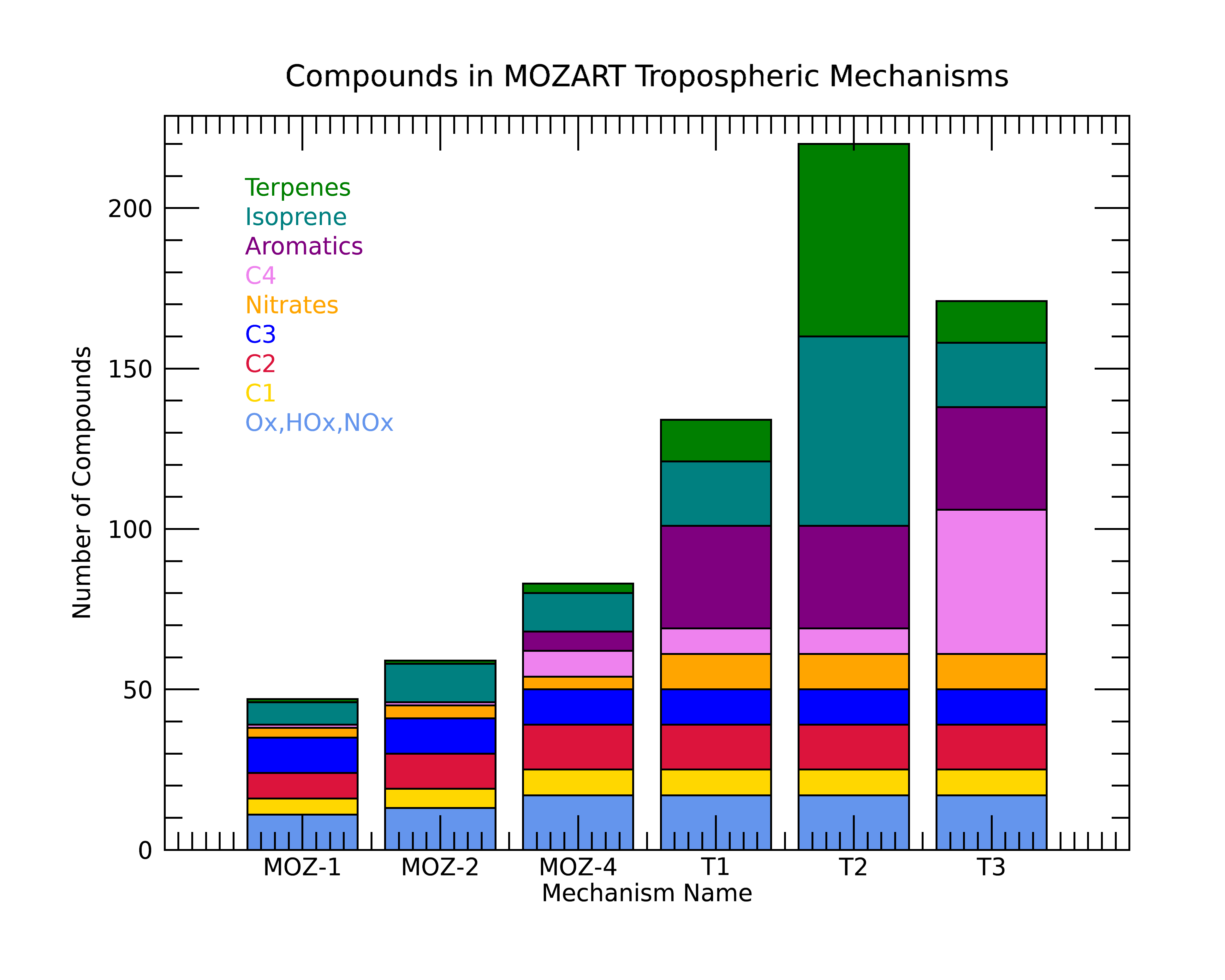MOZART
MOZART: Model for OZone and Related chemical Tracers
MOZART chemical mechanisms
The MOZART chemical mechanisms used in CAM-chem and WACCM (components of the Community Earth System Model) are developed, maintained and updated at NCAR, with collaborations from the community.
A full description of the MOZART mechanism (T1S and TSMLT) in CESM2 is described in Emmons et al., JAMES, 2020. The aerosol schemes used in CESM2, including the Secondary Organic Aerosol (SOA) Volatilty Basis Set (VBS) scheme and the Modal Aerosol Model (MAM), are described in detail in Tilmes et al., JAMES, 2019. The stratospheric chemistry is discussed further in Gettelman et al., JGR, 2019.
Current MOZART mechanisms
Naming convention: T = Troposphere; S = Stratosphere; MLT = Mesosphere and Lower Thermosphere; MA = Middle Atmosphere
| MOZART- | Description | Species |
|---|---|---|
| T1 | Comprehensive tropospheric chemistry | 179 |
| T1.1 | Adds NOx-dependent VBS SOA formation (default in CESM2; Jo et al., 2020) | |
| T1.2 | Reaction rates updated to JPL19. TS1 updated to this in CAM tag cam6_3_095. | |
| T2 | T1 plus detailed terpene oxidation (Schwantes et al., 2020) | 265 |
| T3 | T1 plus speciated higher alkanes | 216 |
| T4 | Simpler tropospheric VOCs | 100 |
| TS1, T1S | T1 with comprehensive stratospheric chemistry; released in CESM2 (Emmons et al., 2020) | 216 |
| TSMLT, T1MA | T1 with Middle Atmosphere (stratosphere, mesosphere & lower thermosphere); used for CMIP6-WACCM | 225 |
| T4S | T4 with stratosphere, suitable for climate simulations (CESM3) | 134 |
| T5S | T1 plus short-lived halogens | |
| T6S | T1 plus speciated butanes & pentanes, furans, HONO, HNCO, with stratospheric chemistry | 308 |
Previous MOZART mechanisms
| Mechanism | Description | Species |
|---|---|---|
| MOZART-1 | Original mechanism based on IMAGES (Brasseur, Hauglustaine et al., JGR, 1998) | 46 |
| MOZART-2 | Expanded hydrocarbons and isoprene oxidation (Horowitz et al, JGR, 2003) | 59 |
| MOZART-3 | Stratospheric chemistry with MOZART-4 troposphere (Kinnison et al., JGR, 2007) | 108 |
| MOZART-4 | Addition of aromatics to MOZART-2 (Emmons et al., 2010) | 83 |


MOZART chemical transport model (CTM)
The MOZART CTM has not been updated since the publication of MOZART-4 (Emmons et al., 2010)., and therefore is quite out of date. The source code is freely available to the community, however it is no longer being developed or supported. The capabilities of MOZART-4, with numerous improvements, are available in CAM-chem and we recommend that it be used. CAM-chem is a component of the Community Earth System Model, so can be run as a fully coupled free-running climate model, but can also be run with specified dynamics (nudged to reanalysis meteorology) to produce results similar to the MOZART CTM. Documentation on Downloading and Running MOZART-4 Source Code